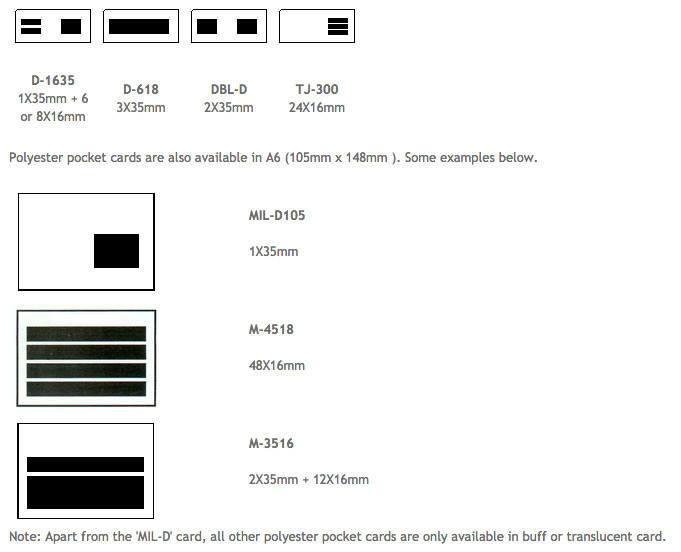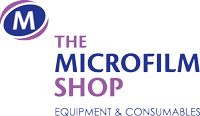Ideal for the storage of individual large format plans, maps, engineering drawings and documents etc on microfilm
What is an Aperture Card?
Aperture cards have developed from the old IBM80 column punch cards. They are basically a piece of card that is normally 82.5mm x 187mm in size with an area of the card dedicated to one frame of 35mm microfilm.
Traditionally aperture cards have been used to store the microfilm copy of large engineering drawings and maps. Each aperture card would hold its very own map or drawing. The actual card itself is used for typing the index reference and for ease of handling to avoid touching the microfilm frame.
Aperture cards are available (like all microfilm formats) in a variety of different types:-
1) Conventional Aperture Cards
As mentioned above, these are 82.5mm x 187mm pieces of card. From this card a square hole or aperture (hence the name) is cut, this hole is approx. 50mm x 40mm (2 x 11/2″). The edges of this hole are lined with an adhesive tape thus allowing one frame of 35mm microfilm to be positioned securely over the hole. This allows the light to shine through the microfilm image enabling it to be read.
The Microfilm Shop is a main dealer for the complete range of 3M imatation aperture cards thus ensuring a guaranteed supply of very high quality aperture cards.
There are 2 basic formats of aperture card:-
i) M1 Aperture Cards
For ease of identification, if you look at the aperture card with the cut corner in the top left, then an M1 card will have the adhesive tape on the rear of the card and the hole (or aperture) will be to the left of the card. When a frame of 35mm microfilm is positioned on to the adhesive tape, the emulsion side of the film will be at the front of the card. (Dimensions for this card are 187mm x 82.5mm)
ii) M4 Aperture Cards
For ease of identification, if you look at the aperture card with the cut corner in the top left, then an M4 card will have the adhesive tape on the front of the card and the hole (or aperture) will be to the right of the card. When a frame of 35mm microfilm is positioned on to the adhesive tape, the emulsion side of the film will be at the rear of the card.
2) Duplicards
These are exactly the same size as conventional aperture cards ie. 82.5mm x 187mm. Instead of having a frame of original silver microfilm placed onto the card, these cards have a piece of diazo emulsion microfilm already pre-mounted onto the adhesive tape. This piece of diazo film has not been exposed, the idea being to place the duplicard exactly underneath the original aperture card and then expose both to ultra-violet light. After developing the duplicard with ammonia, you have created an exact copy of the original aperture card for security or distribution purposes.
As with conventional aperture cards, The Microfilm Shop is a main dealer for the complete range of 3m Imatation duplicards thus ensuring a guaranteed supply of very high quality duplicards.
There are 2 basic formats of duplicard:-
iii) M2 Duplicard
For ease of identification, if you look at the duplicard with the cut corner in the top left, then an M2 duplicard will have the adhesive tape on the front of the card and the frame of diazo will be to the left of the card. The emulsion side of the diazo will face the rear of the card. (Dimensions are 187mm x 82.5mm.
iv) M3 Duplicard
For ease of identification, if you look at the duplicard with the cut corner in the top left, then an M3 duplicard will have the adhesive tape on the rear of the card and the frame of diazo will be to the right of the card. The emulsion side of the diazo will face the front of the card.
Coloured Cards
The standard colour for conventional aperture cards is buff (beige) and for duplicards is salmon. However, other card colours are available for easy indexing, these include:- salmon, buff, white, pink, green, yellow and blue.
Packing
Aperture cards and duplicards are priced per 1,000 cards, however all cards are packed in boxes of 2,000 therefore you must order a minimum of 2,000 cards and in multiples of 2,000.
Pre-printing
In addition to having different coloured cards to suit your indexing system, it is possible to have the cards pre-printed with any information you require. This could be a company logo, an indexing grid or sequential numbering etc. Please contact our sales department to ensure that the correct printing proofs are created. Normally, after a one-off set-up charge, there is no extra cost for pre-printing your information on to the cards.
3) Polyester Pocket Aperture Cards
These are very similar to conventional aperture cards in that they are exactly the same size. Instead of using adhesive tape to secure the frame of microfilm to the card, a polyester pocket sits in the hole (or aperture) of the card. The frame of microfilm is then placed inside the pocket.
By far the most popular type of polyester pocket aperture card is the ‘MIL-D’ card.
The ‘MIL-D’ card holds one frame of 35mm microfilm. This card is traditionally buff in colour but is available in salmon, white, red, green, yellow and blue by special order. These cards are also available in translucent card to enable both the microfilm and the written information to be copied at the same time.
Polyester pocket cards are available in a wide variety of formats to store varying quantities and combinations of not only 35mm but also 16mm frames and strips of microfilm. Below are only a few examples of the entire range, please contact us for further details.

4) Camera Cards
The Microfilm Shop also stocks a complete range of 3Map imation Camera Cards. These are exactly the same size as conventional aperture and duplicards. They are similar to duplicards in that a piece of unexposed film is pre-mounted on to the card. However, instead of a piece of unexposed diazo duplicate film, camera cards have a piece of unexposed silver halide film pre- mounted on to them. This means that camera cards are very light sensitive and should not be exposed to daylight at all. Camera cards are used in special cameras that microfilm large engineering drawings and maps. The microfilmed image is transferred straight from the camera head onto the camera card. After a developing process using chemical developer and fixer, an original master card of the document is produced.
All types of developer, fixer and wash chemicals are available from The Microfilm Shop.
